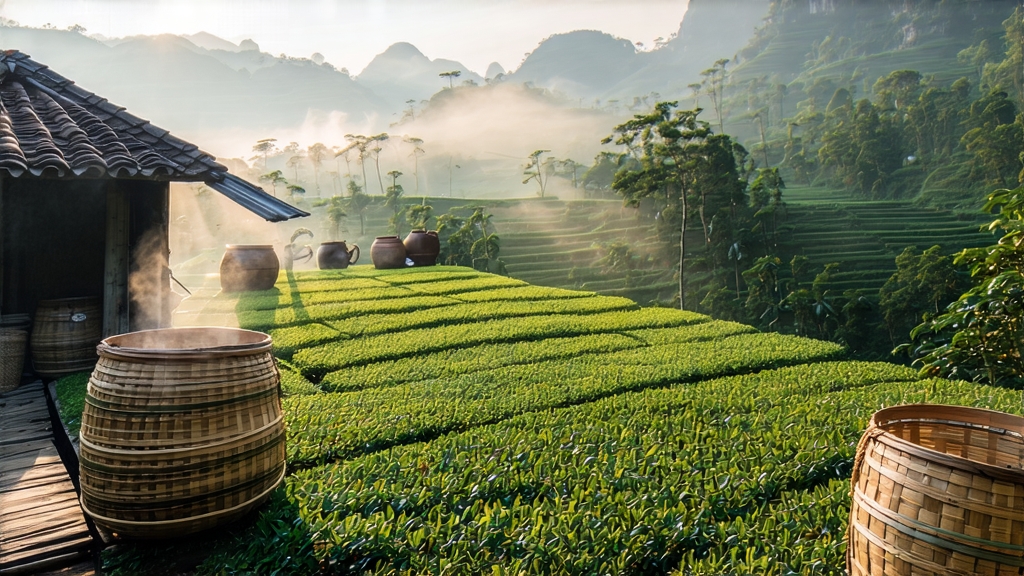
Tucked away in the humid, karst-pocked mountains of southern China’s Guangxi Zhuang Autonomous Region, Liu Bao tea has spent four centuries quietly perfecting the art of time travel. To the uninitiated it looks like dull, brittle twigs; to the initiated it is liquid history—an ebony elixir that ferries the drinker back to Qing-dynasty horse caravans, clandestine river ports, and the medicinal pantries of dockworkers who once believed this tea could “cut the grease” of a month-long rice-diet. Today Liu Bao is enjoying a renaissance among Chinese collectors and is beginning to whisper its smoky-sweet secrets to the wider world. This article invites international tea lovers to listen closely.
-
From Warhorse to Teahouse: A 400-Year Journey
Liu Bao takes its name from the old postal town of Liu Bao in Wuzhou prefecture, the historic trading hub where the Liu River meets the Xi River and then flows toward Guangzhou. In the late Ming dynasty (1600s) farmers of the Yao and Han ethnic groups began pressing their rough autumn leaves into narrow bamboo baskets for porters to carry downriver. By the early Qing the tea had become a currency of sorts: one basket could pay a boatman’s wage, and imperial censors recorded its arrival in the northern garrisons where Manchu officers drank it with yak-butter to counter the heavy mutton fat. The opening of the Hong Kong–Canton trade in the nineteenth century pushed Liu Bao further: British and French clipper captains bought it as ballast, discovering that six months in a damp ship’s hold only deepened its flavor. Thus a tea born for immediate thirst-quenching accidentally learned to age with grace. -
Terroir: Where Rocks Breathe and Rivers Steam
Guangxi’s subtropical climate—90 % humidity, 1 600 mm annual rainfall, and red lateritic soil shot through with limestone—creates a giant natural humidor. The tea gardens sit between 200–600 m above sea level, often on terraced slopes too poor for rice but perfect for the large-leaf Camellia sinensis var. assamica. Morning mountain mists linger until noon, feeding leaf and microbe alike. Locals insist that the “river air” of Wuzhou—laden with aquatic microbes—plays as decisive a role as soil, much like the “fog air” of Bordeaux vineyards. Whatever the science, Liu Bao leaves harvested even ten kilometers inland never quite achieve the same betel-nut aroma. -
Craft: The Six Acts of Transformation
Act I: Picking—only the 3rd to 5th mature leaves are taken after the Qingming festival, when amino acids have subsided and polyphenols have thickened.
Act II: Solar Withering—leaves are spread on bamboo mats for 3–5 hours until they lose 15 % moisture; the sun’s UV triggers early enzymatic oxidation.
Act III: Wok Kill-Green—at 200 °C for eight minutes the leaves are tossed by hand, deactivating most but not all leaf enzymes, a nuance vital for later microbial fermentation.
Act IV: Rolling—twenty minutes of machine rolling ruptures cells without shredding the leaf, preserving integrity for basket storage.
Act V: Wet-Pile Fermentation—unique among Chinese dark teas, Liu Bao undergoes a controlled 10–18 day pile-fermentation at 28–32 °C and 85 % humidity. Workers sprinkle river water, turn the pile twice daily, and monitor internal temperature with bare forearms, the way a baker tests dough. This stage cultivates Eurotium cristatum and other fungi that will later paint golden “golden flowers” on aged cakes.
Act VI: Basket Pressing & Drying—the fermented leaf is steamed for 30 seconds, then rammed by foot into cylindrical bamboo baskets lined with wild banana leaf. A 50 kg basket is left to air-dry for two days, then moved to a pine-wood curing shed where slow charcoal fires (50 °C) reduce moisture to 12 % over the next week. The pine smoke lends a subtle resinous note that later mellows into camphor and dried longan. -
Variations Within the Dark: Grades, Shapes, Ages
Traditional grades run from top “First Class” (tiao